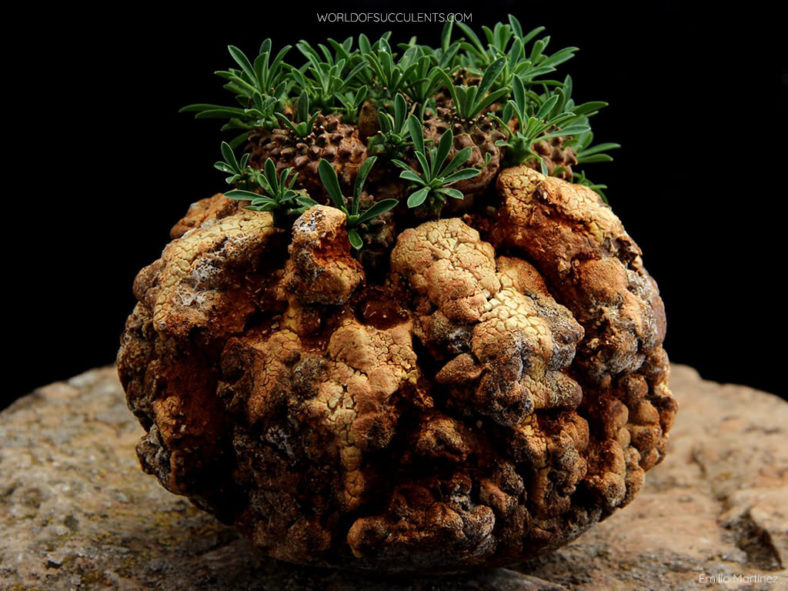Scientific Name
Euphorbia 'Cocklebur'
Synonym(s)
Euphorbia × japonica
Scientific Classification
Family: Euphorbiaceae
Subfamily: Euphorbioideae
Tribe: Euphorbieae
Subtribe: Euphorbiinae
Genus: Euphorbia
Origin
Euphorbia 'Cocklebur' is a hybrid created by Edward Hummel (1903-1979), a nurseryman, horticulturist, and succulent hybridizer from Carlsbad, California, United States. It results from a cross between Euphorbia bupleurifolia and Euphorbia susannae.
Description
Euphorbia 'Cocklebur', also known as Euphorbia × japonica, is a dwarf succulent that develops a short caudex partly underground and produces branches profusely in every direction, forming a dense clump with age. The branches are subspherical, with spirally arranged tubercles, corky scars of fallen leaves, and a tuft of long leaves at the apex, resembling a small pineapple. They can grow up to 2 inches (5 cm) long and 1.6 inches (4 cm) in diameter. The deciduous leaves are green, lance-shaped, measuring up to 2 inches (5 cm) long and about 0.3 inches (0.7 cm) wide.
Flowering has not been observed to date.
Euphorbia 'Cocklebur' is also sold as Euphorbia 'Pineapple Head' or Euphorbia japonica 'Pineapple Head'.

How to Grow and Care for Euphorbia 'Cocklebur'
Light: This succulent is a sun lover. Place your indoor E. 'Cocklebur' in a sunny window. You may place the pot on the balcony or in the garden from spring to fall. Increase sun exposure gradually to prevent sunburn.
Soil: E. 'Cocklebur' requires well-drained soil. Use a commercial potting mix formulated for succulents, or make your own.
Temperature: High summer temperatures are not a problem, but low winter temperatures can damage or kill your plant. E. 'Cocklebur' can withstand temperatures as low as 25 °F (-3.9 °C). USDA Plant Hardiness Zones 9b to 11b, 25 to 50 °F (-3.9 to 10 °C).
Watering: From spring to fall, water when the top inch (2.5 cm) of soil feels dry. Reduce watering in winter. Give it just enough water to prevent wilting. The best time of the day to water your E. 'Cocklebur' in the warm season is the evening.
Fertilizing: Plants in a pot need regular feeding. Apply a balanced fertilizer in a 10-10-10 NPK formulation, diluted to 1/4 strength weekly during the growing season.
Repotting: E. 'Cocklebur' will benefit from repotting, but it does not need to be repotted yearly. When your plant is outgrowing its pot, it is time to repot it in a larger pot and give it a fresh potting mix. The repotting is best done in early spring, at the beginning of the growing season. Wear gloves, protective clothing, and appropriate eye protection when repotting this succulent.
Propagation: This plant is easy to propagate by using stem cuttings. The best time to take cuttings is in spring or summer.
Learn more at How to Grow and Care for Euphorbia.
Toxicity of Euphorbia 'Cocklebur'
E. 'Cocklebur' produces a toxic white milky sap that may cause burns or irritation if in contact with the skin or eyes. Therefore, keeping this plant away from children and pets is best.
Links
- Back to genus Euphorbia
- Succupedia: Browse succulents by Scientific Name, Common Name, Genus, Family, USDA Hardiness Zone, Origin, or cacti by Genus
Photo Gallery
Click on a photo to see a larger version.


